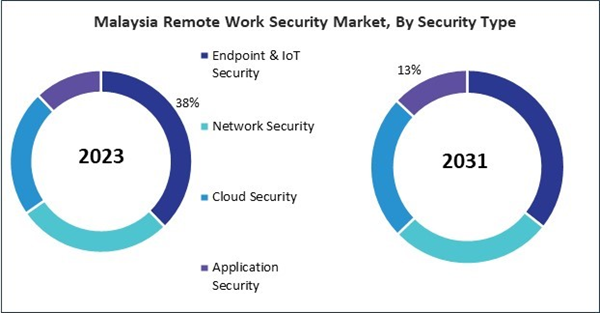The China market dominated the Asia Pacific Remote Work Security Market by Country in 2023, and would continue to be a dominant market till 2031; thereby, achieving a market value of $18.55 billion by 2031. The Japan market is registering a CAGR of 21.5% during 2024-2031. Additionally, the India market would showcase a CAGR of 23.1% during 2024-2031.
Several key trends have influenced the adoption of remote work security solutions. As organizations adopt hybrid work models combining in-office and remote work, there is a growing demand for security solutions that seamlessly integrate and manage security across both environments, ensuring consistent protection regardless of where employees work. With the increasing use of edge computing in remote work setups, there is a trend toward adopting edge security solutions that provide real-time protection and threat detection closer to the data source, enhancing security for remote devices and applications.
Organizations prioritize adopting secure remote access solutions, such as secure access service edge (SASE) and zero trust network access (ZTNA), to ensure remote users can securely access corporate resources without compromising security. The shift towards cloud-based applications and services has led to the adoption of cloud-native security tools specifically designed to protect cloud environments. This includes solutions for cloud workload protection and cloud security posture management.
With the rise of EdTech, there is an increased reliance on online learning platforms and virtual classrooms. This drives demand for secure remote work solutions to protect educational content, student data, and communication between educators and learners. As per the International Trade Administration, China had the largest state-run education system in the world, with 291 million students and 18 million teachers in over 529,000 schools in 2021. China’s education technology sector entered a rapid growth stage from 2017 to 2020, with the industry’s total revenue increasing from $46.4 billion to $61.1 billion. The BFSI sector handles highly sensitive financial data, including personal and transactional information. To safeguard this data from unauthorized access and intrusions, there is an increasing demand for robust security measures as remote work becomes more prevalent. The rapid expansion of the BFSI sector in India significantly influences the anti-theft system market. India’s banking sector has long been considered one of the world’s most stable. In conclusion, the rising tech industry and increasing BFSI sector in the region drive the market’s growth.
List of Key Companies Profiled
- Cisco Systems, Inc.
- VMware, Inc. (Broadcom Inc.)
- Palo Alto Networks, Inc.
- Check Point Software Technologies Ltd.
- Trend Micro, Inc.
- Fortinet, Inc.
- IBM Corporation
- Microsoft Corporation
- Sophos Group PLC (Thoma Bravo)
- Cloudflare, Inc.
Market Report Segmentation
By Offering
- Solution
- Services
By Work Model
- Full Remote
- Hybrid
- Temporary Remote
Security Type
- Endpoint & IoT Security
- Network Security
- Cloud Security
- Application Security
By End User
- BFSI
- IT & Telecom
- Government
- Retail & E-Commerce
- Education
- Media & Entertainment
- Others
By Country
- China
- Japan
- India
- South Korea
- Singapore
- Malaysia
- Rest of Asia Pacific
Table of Contents
Companies Mentioned
- Cisco Systems, Inc.
- VMware, Inc. (Broadcom Inc.)
- Palo Alto Networks, Inc.
- Check Point Software Technologies Ltd.
- Trend Micro, Inc.
- Fortinet, Inc.
- IBM Corporation
- Microsoft Corporation
- Sophos Group PLC (Thoma Bravo)
- Cloudflare, Inc.
Methodology

LOADING...









